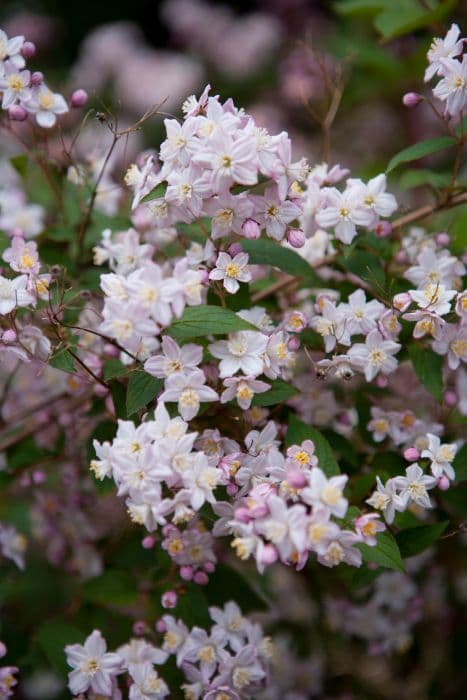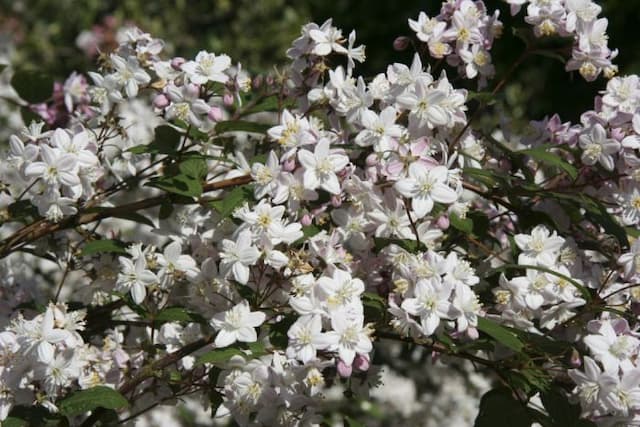Bigleaf Hydrangea Hydrangea macrophylla 'Tokyo Delight' (L)

ABOUT
The 'Tokyo Delight' hydrangea is a stunning deciduous shrub that boasts large, round flower heads made up of multiple individual blooms. The flowers are a true eye-catcher, displaying a beautiful array of colors as they mature. Initially, the blooms appear in a creamy white hue, but as they age, they transform into a rich pink that adds a splash of vibrancy to any garden setting. The variation in color can be influenced by the soil pH, which can shift the pink towards a more blue or purple shade if the soil is more acidic. The lush, dark green leaves of the 'Tokyo Delight' hydrangea provide a striking contrast to the bright flower colors, creating a lush backdrop that highlights the blooms. These leaves are broadly ovate with a somewhat glossy surface and serrated edges, contributing to the plant's overall aesthetic. The 'Tokyo Delight' hydrangea's flowers bloom in summer, offering a long-lasting display that can continue well into fall. This makes the plant not only a visual standout but also one that can contribute long-term interest and color to gardens during the growing season. Their full, rounded shape and ability to change color make them a favorite among gardeners who seek to add a dynamic and changing element to their landscapes.
About this plant
 Names
NamesFamily
Hydrangeaceae
Synonyms
Bigleaf Hydrangea, French Hydrangea, Lacecap Hydrangea, Mophead Hydrangea, Penny Mac, Hortensia
Common names
Hydrangea macrophylla 'Tokyo Delight' (L).
 Toxicity
ToxicityTo humans
The common name for Hydrangea macrophylla 'Tokyo Delight' is Hydrangea. Hydrangeas are considered to have low toxicity to humans. However, if ingested, parts of the plant can cause stomach upset, with symptoms including nausea, vomiting, and diarrhea. This is due to the presence of cyanogenic glycosides in the leaves and flower buds, which can release cyanide in the body. Ingesting large quantities could potentially result in more serious symptoms, but such cases are rare.
To pets
The Hydrangea plant can be toxic to pets if ingested. The symptoms of poisoning in pets may include vomiting, diarrhea, depression, and lethargy. In some cases, ingestion can also lead to an increase in heart rate and hyperthermia. Cyanogenic glycosides, which are present in the plant, are the main toxic agents that can release cyanide when metabolized. Pets consuming parts of the Hydrangea plant should receive prompt veterinary attention to manage symptoms and prevent more serious complications.
 Characteristics
CharacteristicsLife cycle
Perennials
Foliage type
Deciduous
Color of leaves
Green
Flower color
Pink or Varies
Height
4-6 feet (1.2-1.8 meters)
Spread
4-6 feet (1.2-1.8 meters)
Plant type
Shrub
Hardiness zones
5-9
Native area
Japan
Benefits
 General Benefits
General Benefits- Aesthetic Appeal: The Hydrangea macrophylla 'Tokyo Delight' adds visual interest to gardens with its large, showy blooms that can vary in color from pink to blue, depending on soil pH.
- Seasonal Interest: This plant provides a long blooming season, typically from early summer to late fall, offering continual beauty throughout the growing months.
- Landscape Versatility: It can be used in a variety of garden settings, including borders, foundation plantings, and as a focal point in floral arrangements.
- Wildlife Attraction: The blossoms can attract pollinators like bees and butterflies, contributing to the health of the garden ecosystem.
- Ease of Cultivation: Hydrangea macrophylla 'Tokyo Delight' is known for being relatively easy to grow and maintain, making it a good choice for both experienced and novice gardeners.
- Hardiness: This variety of hydrangea is quite hardy and can withstand cooler climates, making it suitable for a wide range of geographical locations.
- Soil Adaptability: The plant is adaptable to various soil types, although it prefers moist, well-drained soils.
- Pruning Tolerance: It responds well to pruning, which can be used to control the size and shape of the plant, as well as to promote more vigorous blooming.
 Medical Properties
Medical PropertiesThis plant is not used for medical purposes.
 Air-purifying Qualities
Air-purifying QualitiesThis plant is not specifically known for air purifying qualities.
 Other Uses
Other Uses- Hydrangea blossoms can be used to create a natural dye for fabric, yielding shades of blue, purple, or pink depending on the pH of the water used.
- The dried flowers of the Hydrangea can be crushed to make a colorful pigment for artist paints.
- Fresh Hydrangea flowers can be used to make an infusion for soaking bath bombs, adding a floral scent and skin-soothing properties.
- Decorative pressings can be made from the flowers for creating bookmarks, greeting cards, or framed botanical art.
- Leaves and blooms can be used in the craft of potpourri, contributing to both visuals and fragrance after proper drying and treatment.
- Gardeners can use the color-changing properties of the flowers to teach principles of soil pH to students and gardening enthusiasts.
- Blooms of the Hydrangea can be used in the culinary field as a delicate, edible garnish for desserts and special dishes, as long as they are free from pesticides.
- The sturdy stems of Hydrangea can be used in basket weaving to create decorative elements or as part of the weaving structure itself.
- Hydrangea flowers can serve as inspiration for artists and designers, influencing fabric patterns, wallpaper designs, and even jewelry.
- During festive seasons, Hydrangea flowers can be incorporated into wreaths, garlands, or table centerpieces for a splash of color.
Interesting Facts
 Feng Shui
Feng ShuiThe Hydrangea is not used in Feng Shui practice.
 Zodiac Sign Compitability
Zodiac Sign CompitabilityThe Hydrangea is not used in astrology practice.
 Plant Symbolism
Plant Symbolism- Heartfelt and Sincere Emotions: Hydrangeas often represent deep feelings of love and understanding due to their full and abundant flower heads.
- Gratitude for Being Understood: The hydrangea can symbolize gratitude and enlightenment, as it is believed to express thankfulness for someone's insightful comprehension.
- Apology or Forgiveness: In some contexts, gifting hydrangeas may serve as an expression of apology or as an offer of forgiveness.
- Frivolity and Boastfulness: Historically, hydrangeas have been associated with vanity and boastfulness due to their showy appearance.
- Abundance and Wealth: With their lush blooms, hydrangeas can symbolize abundance and prosperity.
- Fourth Wedding Anniversary: Hydrangeas are often associated with the fourth wedding anniversary, symbolizing appreciation and enduring love.
 Water
WaterBigleaf Hydrangeas require consistent moisture and should be watered deeply about three times a week, ensuring the soil is moist but not waterlogged. During periods of high heat or dry spells, increase watering to maintain soil moisture. Each watering session for an established plant should consist of about 1 to 1.5 gallons of water. Monitor the plant's leaves for signs of wilting, which indicate the need for more water, and during the winter, reduce watering frequency since the plant will be dormant.
 Light
LightBigleaf Hydrangea thrives in conditions where it receives morning sun and afternoon shade. The ideal spot is one where the plant is protected from the intense midday heat but can soak up gentle morning rays. Avoid placing it in full shade or full sun, as too little light can inhibit blooming, while too much can scorch the leaves.
 Temperature
TemperatureBigleaf Hydrangea prefers a range where daytime temperatures are between 65°F and 75°F, with nighttime temperatures slightly lower but ideally not below 50°F. This plant can generally tolerate temperatures as low as 20°F, but hard freezes may damage the flower buds. The optimal growing conditions for this hydrangea are moderate temperatures with high humidity.
 Pruning
PruningBigleaf Hydrangea should be pruned to remove dead branches and encourage the plant's natural shape, typically immediately after flowering has ceased, as it blooms on old wood. Lightly prune just above the first pair of healthy buds below the spent blooms. Pruning too late in the season may result in cutting off next year's flower buds, so early summer or late spring is ideal.
 Cleaning
CleaningAs needed
 Soil
SoilThe best soil mix for Hydrangea, commonly known as hortensia, should be rich, porous, and well-draining with an even mix of peat, compost, and pine bark. Hortensias prefer a soil pH that affects bloom color, ranging from 5.2 to 5.5 for blue flowers and 6.0 to 6.2 for pink flowers.
 Repotting
RepottingHortensias should be repotted every 2-3 years or when the root system outgrows the container. This will ensure the plant has enough space and fresh soil to continue growing healthily.
 Humidity & Misting
Humidity & MistingHortensias thrive in environments with high humidity levels, ideally between 60% to 70%. If indoor air is too dry, consider using a humidifier or placing a water tray nearby to increase humidity.
 Suitable locations
Suitable locationsIndoor
Place hortensia in bright, indirect light and maintain high humidity.
Outdoor
Ensure partial shade, shelter from winds, mulch well, and keep soil moist.
Hardiness zone
6-9 USDA
 Life cycle
Life cycleThe 'Tokyo Delight' hydrangea, a cultivar of Hydrangea macrophylla, begins its life cycle when a seed germinates in spring, given appropriate moisture and soil conditions. Emerging as a seedling, the plant then develops a root system and foliage through vegetative growth. Over the next few years, it matures and forms a woody structure, allowing it to withstand colder temperatures and become a perennial presence in the garden. The hydrangea enters a particularly prolific phase of blooming in early to mid-summer, showcasing large mophead flowers that shift color based on soil pH. After the flowering period, which can last through late summer, the plant sets seeds which may drop and germinate nearby, beginning a new cycle. During the winter months, the 'Tokyo Delight' hydrangea becomes dormant, losing its leaves and storing energy in the roots for the next growing season.
 Propogation
PropogationPropogation time
Spring-Early Summer
The most popular method for propagating Hydrangea macrophylla 'Tokyo Delight', commonly known as Bigleaf Hydrangea, is through softwood or semi-hardwood cuttings. This technique is typically performed in late spring to early summer. A healthy, non-flowering shoot is selected and a cutting about 5 to 6 inches long with several leaves is taken. The lower leaves are removed, and the cut end is dipped in rooting hormone powder to encourage root development. This cutting is then inserted into a pot filled with a well-draining potting mix or a 50:50 blend of peat and perlite. The pot is placed in a warm, humid environment but out of direct sunlight to prevent desiccation. Regular misting helps maintain humidity levels, and roots usually form within 4 to 6 weeks.








![Hydrangea [Early Sensation]](/_next/image?url=https%3A%2F%2Fplants-admin.emdemapps.com%2Fimages%2Fplants%2F%2Fimages%2F604b6150338db.png&w=640&q=75)
